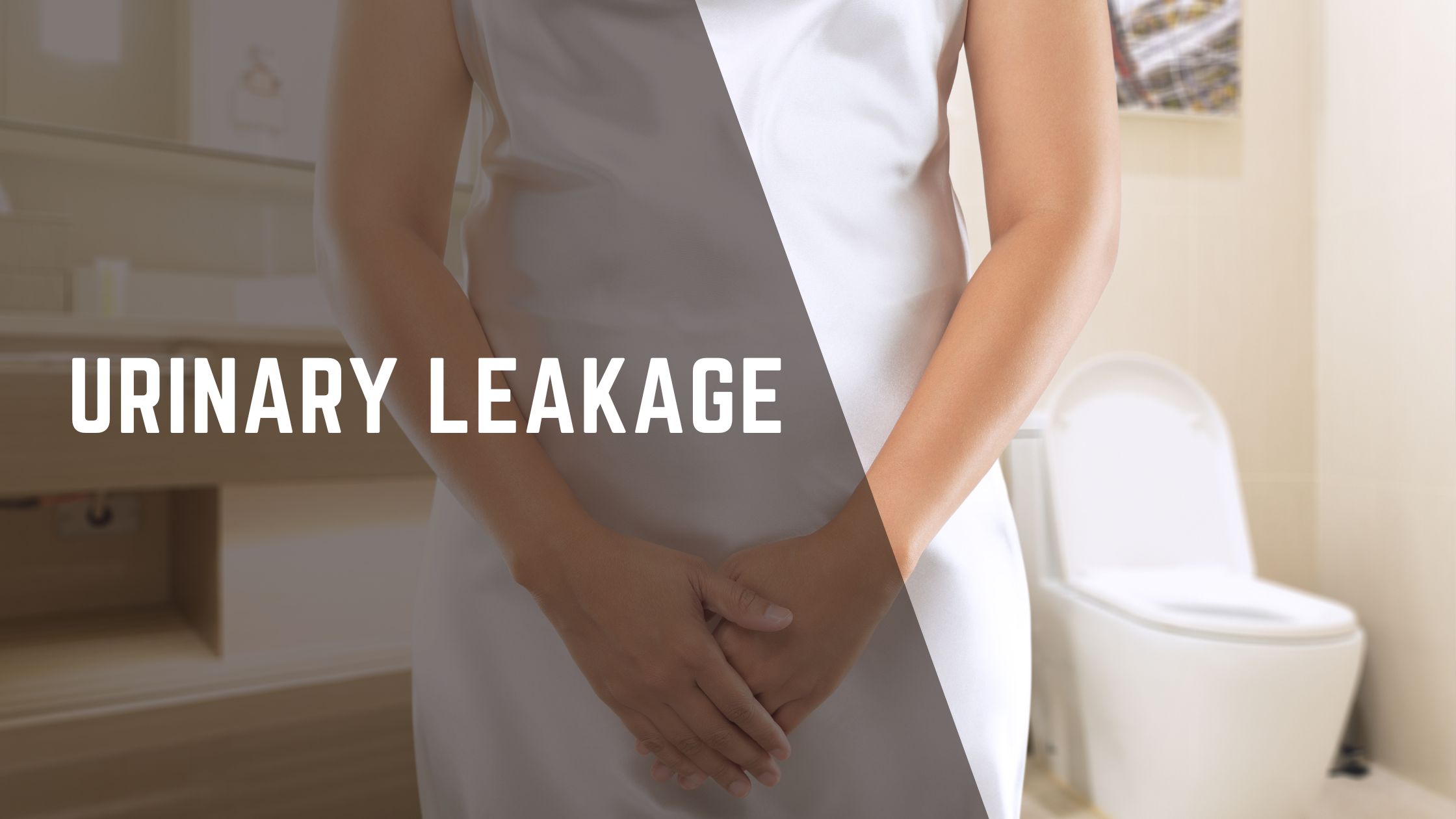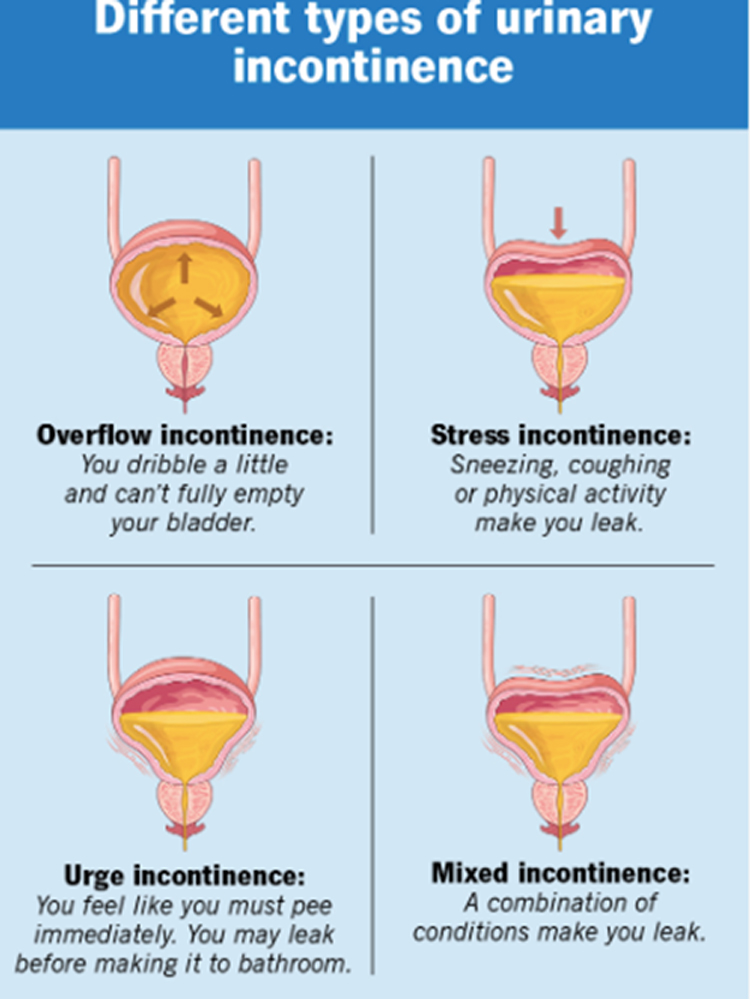
Urinary Leakage
Urinary incontinence is when you lose control of your bladder and leak pee. It’s a condition that can have a negative effect on your life.
Your urinary system consists of many different organs. These organs work together to filter, store and remove waste from your body as pee (urine). When your urinary system works as expected, you usually have time to get to a bathroom to pee, and you don’t leak pee. Urinary incontinence occurs when these parts don’t operate as they should. This can happen for many different reasons throughout your life.
Many people think incontinence is a normal part of getting older, and you can’t do anything to stop it. It’s true that your risk of incontinence increases as you get older. But it can happen to anyone, regardless of age. And treatments are available to help you manage it. Incontinence doesn’t have to disrupt your life or keep you from being active.
Urinary incontinence is very common. About 62% of females age 20 and older have some type of urinary incontinence. In males, a little less than 14% have incontinence

What are the different types of incontinence?
There are many different types of incontinence. They have different causes, characteristics and triggers. Knowing the type of incontinence is an important part of your diagnosis and treatment plan.
Types of incontinence include:
- Urge incontinence. Urge incontinence causes an intense need to pee right away. Many times, it happens too quickly for you to make it to a toilet, and you leak pee. Overactive bladder is a common cause of urge incontinence.
- Stress incontinence. Stress incontinence is when you leak pee during certain activities, such as laughing, coughing, sneezing, running, jumping or lifting heavy objects.
- Overflow incontinence. Overflow incontinence is when your bladder doesn’t completely empty each time you pee. You’re more likely to have overflow incontinence if you have an enlarged prostate (benign prostatic hyperplasia) or other conditions like stroke or diabetes.
- Mixed incontinence. Mixed incontinence is when you have a combination of several conditions that all lead to bladder leakage problems. For example, you may have stress incontinence and an overactive bladder. If you have mixed incontinence, pay attention to what you’re doing when you leak. Providers can help you figure out what type of incontinence you have and talk to you about ways to manage it. A good first step is figuring out what triggers it.
Symptoms and Causes
What are the symptoms of incontinence?
The primary symptom of incontinence is leaking pee before you can make it to the bathroom or during activities like sneezing, coughing, laughing or exercising. If you have incontinence, you might leak a lot of pee or a small amount. It could be a constant drip or an occasional leak. Your symptoms usually depend on the type of incontinence you have. But they may include:
- Peeing more than eight times a day (frequent urination)
- Needing to use the bathroom but only a little amount comes out each time
- Waking up to pee more than twice (nocturia)
- Wetting the bed (enuresis)
- Leaking pee during activities like exercise, laughing, coughing, sneezing, bending over or having sexual intercourse
Why am I not able to hold my pee?
There are many different reasons why you might not be able to hold your pee. These may vary depending on if you’re female or male. Some causes are temporary and go away with treatment. Other causes may be chronic medical conditions. Even with treatment, chronic conditions may not go away, and you may have to manage incontinence over time as a symptom of your condition.
Temporary or short-term causes of incontinence may include:
- Urinary tract infections (UTIs)
- Pregnancy or after delivery
- Certain medications, including water pills (diuretics) and antidepressants
- Certain beverages, like coffee and alcohol
- Constipation
Chronic causes of incontinence may include:
- Overactive bladder
- Stroke
- Diabetes
- Menopause
- Multiple sclerosis (MS)
- Parkinson’s disease
- Enlarged prostate
- Prostate surgery (prostatectomy)
Why does pregnancy cause incontinence?
Pregnancy may cause incontinence for the following reasons:
- Pressure against your bladder. During pregnancy, your body goes through a lot of changes. A few things can happen as a fetus grows and your uterus stretches. The fetus may squish against your bladder, so you have to pee more than usual. This can become even more challenging toward the end of pregnancy when the fetus is at its largest.
- Weak pelvic floor muscles. Your pelvic floor muscles may get weaker during pregnancy and after delivery. These muscles support all the organs in your pelvis. As your uterus grows during pregnancy or after delivery, the muscles can stretch and weaken.
Who does incontinence affect?
Anyone can get incontinence. But it’s more common in certain groups of people and at certain times in your life. In females, incontinence often relates to:
- Pregnancy
- Childbirth
- Menopause
Each of these can cause your pelvic floor muscles to weaken over time and make changes to your bladder that might lead to incontinence.
Am I at a higher risk of incontinence at an older age?
Yes, you’re at a higher risk of incontinence as you get older — usually over the age of 50. Your body constantly changes throughout your life.
Your risk for developing incontinence as you age might be higher if you:
- Have a chronic health condition
- Have given birth
- Are in postmenopause
- Have an enlarged prostate
- Had prostate surgery
It’s important to talk to a healthcare provider about your incontinence risks, including ways you can manage incontinence without it interfering with your daily life.
Is incontinence more common in women?
Yes, incontinence is more common in females. Pregnancy, childbirth and menopause can all lead to bladder control problems.
Pregnancy can be a short-term cause of incontinence. But bladder control issues usually get better after childbirth. Some people have experience after delivery (postpartum) because childbirth strains and weakens your pelvic floor muscles.
Menopause also causes a lot of changes in your body. Your hormones, especially estrogen, change during menopause, which can affect how you can control your bladder.
Diagnosis and Tests
How is incontinence diagnosed?
A healthcare provider can diagnose incontinence by reviewing your symptoms and medical history and performing a physical exam. They may ask you questions, such as:
- How often do you pee?
- Do you leak pee between trips to the toilet?
- How often do you leak pee?
- How much pee do you leak each time?
- When did you first notice you were leaking pee?
- What medications are you currently taking or have you taken in the past?
- Are you pregnant or have you ever been pregnant?
- How many times have you given birth?
These questions help a provider determine a pattern in your leakage, which helps them diagnose the type of incontinence. They may also perform or order tests to help them confirm the incontinence.
What tests will be done to diagnose urinary incontinence?
A healthcare provider may order the following tests to help diagnose incontinence:
- Pelvic exam. A pelvic exam can help determine your pelvic muscle strength and make sure there are no other health problems that could cause incontinence.
- Digital rectal exam. A digital rectal exam can help a provider diagnose an enlarged prostate.
- Pee test (urinalysis). You’ll provide a pee sample, and a provider will examine it for signs of infection or blood in your pee (hematuria).
- Bladder ultrasound. An ultrasound is a painless test that allows a look at your bladder and checks how well you can empty pee.
- Stress test. If you notice that you leak during certain activities, like coughing, running or jumping, a provider may ask you to repeat the actions to see if you leak.
- Cystoscopy. A provider will insert a thin tube with a camera at the end (cystoscope) into your urethra and guide it up to your bladder to examine your urinary system. Most people don’t need a cystoscopy to check for incontinence.
- Urodynamic tests. This is a series of tests that check how much pee your bladder can hold, and how well you can hold pee and then empty your bladder.
- Pad test. A provider may give you a special pad to wear in your underwear, which will catch any pee that you may leak. At the end of the test, they’ll check the pad to see how much pee it contains.
A provider may also recommend that you keep track of any bladder leaks in a journal (bladder diary) for a few days. They may be able to identify a pattern with this information and diagnose a specific type of incontinence. Be sure to write down:
- How often you pee
- How much you’re able to pee each time
- If you leak between trips to the bathroom
- Any activities you’re doing when you leak
Don’t forget to bring your bladder diary with you to your appointment.
Management and Treatment
How do you fix urinary incontinence?
It depends. A healthcare provider must diagnose the type of continence. They’ll also talk to you about the available treatments and help you choose the one you’re most comfortable with.
The main types of urinary incontinence treatments are:
- Lifestyle changes
- Physical therapy
- Medications
- Surgery or other procedures
Each option has pros and cons that a provider will go over with you.
N.B. The content provided on this blog page has been sourced from definitive and credible resources to ensure accuracy and reliability. We do not claim ownership of all the information shared.




